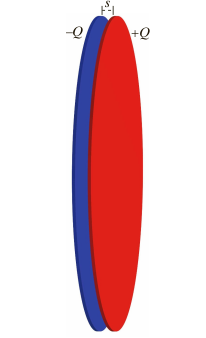Capacitor
This page is about Capacitors and how they work.
The Main Idea
A capacitor is made up of two uniformly charged disks. It is able to store electricity in an electric field. They are able to continue the functions of electronics for a short time while they are unplugged. They essentially are able to act like a power supply by storing electricity.
Theory of operation
Overview
A capacitor is made of two conductors separated by a
Capacitance
Capacitance is the ability of something to store a charge. This is important to a capacitor and allows us to measure how effective it is. The higher the capacitance number is the more charge a capacitor can hold.
Capacitance in a circuit is found by the following:
[math]\displaystyle{ \ C=\frac{q}{V} }[/math]
Electric Field

Electric Field of two uniformly charged disks: A Capacitor
Electric field near the center of a two-plate capacitor
[math]\displaystyle{ \ E=\frac{Q/A}{\epsilon_0 } }[/math] One plate has charge [math]\displaystyle{ \ +Q }[/math] and other plate has charge [math]\displaystyle{ \ -Q }[/math]; each plate has area A; Direction is perpendicular to the plates. Assumption: separation between capacitor is very small compared to the area of a plate.
Fringe Field (just outside the plates near center of disk)
[math]\displaystyle{ \ E_{fringe}=\frac{Q/A}{2\epsilon_0 }(\frac{s}{R}) }[/math] [math]\displaystyle{ \ s }[/math] is the separation between plates; [math]\displaystyle{ \ R }[/math] is the radius of plate
The Algorithm
Step 1. Cut up the charge distribution into pieces and find the direction of [math]\displaystyle{ \Delta \vec{E} }[/math] at each location
Approximate electric field of a uniformly charged disk [math]\displaystyle{ \ E=\frac{Q/A}{2\epsilon_0 }[1-\frac{s}{R}] }[/math] or [math]\displaystyle{ \ E=\frac{Q/A}{2\epsilon_0 } }[/math]
At location 2, midpoint between two disks, both disks contribute electric field in the same direction. Therefore, [math]\displaystyle{ \vec{E}_{net} }[/math] is the largest at this location.
At location 1, because negative charged plate is closer, [math]\displaystyle{ \vec{E}_{net} }[/math] is to the right.
At location 3, because positive charged plate is closer, [math]\displaystyle{ \vec{E}_{net} }[/math] is to the left.
Step 2. Find the electric field of each plate
Assumption: Ignore the electric field due to the small charges on the outer surface of the capacitor since it's very small; Assume that separation between capacitor is very small compared to radius or a disk; consider that location 1 and 3 are just near the disk
To make equation valid at all locations, choose origin at the inner face of the left disk so Electric field of the negative charged plate is [math]\displaystyle{ \ E_{-}=\frac{Q/A}{2\epsilon_0 }[1-\frac{s}{R}] }[/math] to the left and Electric field of the positive charged plate is [math]\displaystyle{ \ E_{+}=\frac{Q/A}{2\epsilon_0 }[1-\frac{s-z}{R}] }[/math] to the left
Step 3. Add up
Location 2: Therefore, the location 2, middle of the capacitor, is located z from the negative charged plate and s-z from the positive plate. Since they are in same direction, we simply add them to find [math]\displaystyle{ \vec{E}_{net} }[/math]
[math]\displaystyle{ \vec{E}_{net} = \ E_{-} + \ E_{+} =\frac{Q/A}{2\epsilon_0 }[1-\frac{z}{R}] + \frac{Q/A}{2\epsilon_0 }[1-\frac{s-z}{R}] = \frac{Q/A}{\epsilon_0 }[1-\frac{s/2}{R}] = \frac{Q/A}{\epsilon_0 } }[/math]
Location 1: At location 1, we can see that [math]\displaystyle{ \vec{E}_{net} = \ E_{-} - \ E_{+} = \frac{Q/A}{2\epsilon_0 }[1-\frac{z}{R}] - \frac{Q/A}{2\epsilon_0 }[1-\frac{z+s}{R}] = \frac{Q/A}{2\epsilon_0 }(s/R) }[/math]
Location 3: At location 1, we can see that [math]\displaystyle{ \vec{E}_{net} = \ E_{+} - \ E_{-} = \frac{Q/A}{2\epsilon_0 }[1-\frac{z-s}{R}] - \frac{Q/A}{2\epsilon_0 }[1-\frac{z}{R}] = \frac{Q/A}{2\epsilon_0 }(s/R) }[/math]
Step 4. Check Unit
[math]\displaystyle{ \frac{C/m^2}{N*m^2/C^2} = \frac{N}{C} }[/math]
[math]\displaystyle{ (\frac{C/m^2}{N*m^2/C^2})(m/m) = \frac{N}{C} }[/math]
Examples
For a two-disk capacitor with radius 50cm with gap of 1mm what is the maximum charge that can be placed on the disks without a spark forming? Under these conditions, what is the strength of the fringe field just outside the center of the capacitor? The air breaks down and a spark forms when the electric field in air exceeds 3e6 N/C
First, convert lengths to meter
[math]\displaystyle{ 50cm = 0.5 m }[/math]
[math]\displaystyle{ 1mm = 0.001mm }[/math]
Second, set up the equation [math]\displaystyle{ 3e6 N/C= \frac{Q/A}{\epsilon_0 } }[/math]
Third, solve for Q
[math]\displaystyle{ A= 0.5*0.5*3.14 = 0.785 }[/math]
[math]\displaystyle{ Q= 3e6*8.85e-12*0.785 = 2.01e-5 }[/math]
[math]\displaystyle{ E_(fringe) = \frac{Q/A}{2\epsilon_0 }(s/R) }[/math]
[math]\displaystyle{ \frac{(2.01e-5)/(0.785)}{2\epsilon_0 }(0.001/0.5) = 3000 N/C }[/math]
History
The first capacitor was created in 1745 by a man named Ewald Georg von Kleist. He was from Pomerania, Germany. He connected a generator to a wire and ran it to a glass jar lined with metal foil and filled with water. This was a rough idea of a capacitor and was not able to store electricity yet. Rather, it proved a concept. In 1746, Pieter van Musschenbroek, a Dutchman, created a similar capacitor and named if the Leyden jar. Both men noticed a much larger shock from the generator when it was connected to a jar of waster. The current issue was that the storage capacity of the jar was not big enough and it discharged almost immediately. Later on, Daniel Gralath connected multiple jars together in parallel to increase the storage capacity. Benjamin Franklin found that the charge was being stored in the glass and not the water. He also coined the term "battery" as it is used in this capacity. The Leyden jar was used until 1900 when smaller capacitors with larger capacities were needed. Capacitors saw many forms before reaching what they are today. Today they are made with a dielectric (insulating materials) sandwiched between metal plates.
See also
Internet resource for capacitor: http://hyperphysics.phy-astr.gsu.edu/hbase/electric/pplate.html
References
Matter and Interactions, 4th Edition http://www.eaton.com/Eaton/ProductsServices/Electrical/ProductsandServices/PowerQualityandMonitoring/PowerFactorCorrection/index.htm http://hyperphysics.phy-astr.gsu.edu/hbase/electric/pplate.html